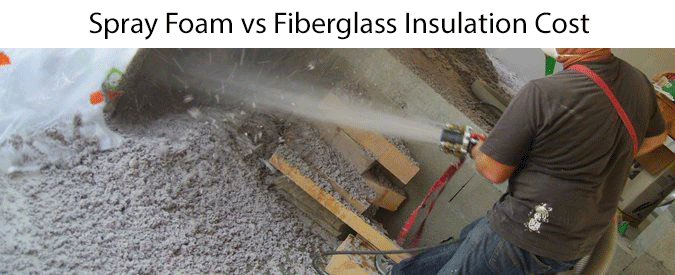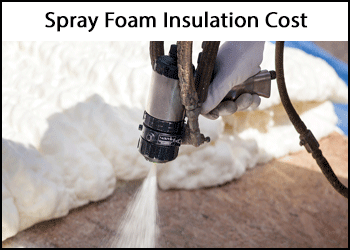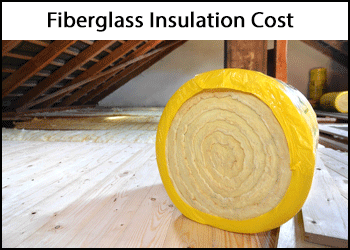Last Updated: February 14, 2023
Compare Spray Foam vs Fiberglass Insulation Costs
Try Our Free Insulation Cost Calculator
Fill out our 30 second free form to receive competitive pricing from pre-screened insulation companies. No commitments. Our service is always free!
Summary: Average Cost of Spray Foam vs Fiberglass Insulation
One board foot (12" x 12" x 1") of open-cell foam insulation averages $0.45 to $0.80 cents. The same amount of closed cell insulation costs between $1 and $2. A square foot of fiberglass costs between $1.30 and $3.50 on average. Fiberglass batts cost between $0.65 and $1.20, while a square foot of blown-in fiberglass costs between $0.50 and $1.

How to Estimate Insulation Costs
When estimating spray foam insulation costs, the first thing you need to know is how much insulation you need. Most contractors charge by the board foot, which measures 12" wide by 12" long by 1" thick.
Determine the board footage of your space by measuring both the square footage of the area and then multiplying that number by the depth in inches. So, an area measuring 14' wide and 10' long would be 140 square feet. A depth of 1" would give you 140 board feet of insulation. If it were 2", you'd need 280 board feet, and so on.
Another factor that impacts cost is the R value of the insulation. This is the measurement of how well the insulation resists heat. In other words, how effective it is at insulating a space. Higher R values indicate a more effective product. You usually see it listed as R6, R7, R13, etc.
In addition, the R value multiplies for each layer of insulation installed. So, if the product is rated R6 for 1", applying 2" gives you R12, 3" gives you R18, etc.
One factor unique to fiberglass insulation is whether the material is faced or unfaced. You find faced insulation in rolls or batts.
Finally, whether you choose open-cell spray foam or closed-cell plays a role, with open-cell coming in at a lower cost. That is mostly due to the higher R value of closed-cell insulation.

How Much Does Spray Foam Insulation Cost?
First, let's look at average costs for each type of spray foam insulation:
Open-cell spray foam insulation averages between $0.45 and $0.80 per board foot
Closed-cell spray foam insulation averages between $1 and $2 per board foot
Total cost, including installation, averages between $3.95 and $7.20 per board foot, depending on the quality of the insulation you choose
Next, we look at specific pricing for different brands, R values, and more.
Dow Froth-Pak 620 contains 620 board feet per set. It's rated R6.2 at 1" depth and averages between $550 and $600 per set.
Foam It Green contains 602 board feet per set. It's rated R7 at 1" and averages between $550 and $730 per set.
Handi-Foam 605 contains 605 board feet per set plus a 15' hose and replacement spray nozzles. It is rated R6.2 at 1" and averages between $660 and $720 per set.
Johns Manville Corbond III contains 5,200 board feet per set. It is rated R21 at 3" and R42 at 6", with an average cost between $2,200 and $2,400 per set.
These prices do not include installation.
Try Our Free Insulation Cost Calculator
Fill out our 30 second free form to receive competitive pricing from pre-screened insulation companies. No commitments. Our service is always free!

Fiberglass Insulation Costs
Fiberglass insulation tends to come in at a lower cost. General costs include:
- Materials average between $0.40 and $0.75 per square foot
- Installation averages between $1.25 and $2.65 per square foot
- The total cost with installation averages between $1.65 and $3.40 per square foot
Next, we look at specific costs for the different types of fiberglass insulation, including rolls, blown-in, and batts.
- CertainTeed Insulsafe SP is blown insulation rated R30. One package containing 67.1 square feet costs between $22 and $31 on average.
- EcoTouch PINK is rolled fiberglass, rated R19, and kraft-faced. One packages containing 48.96 square feet averages between $20 and $29.
- Johns Manville offers a mineral wool batt insulation that includes a sound barrier and is rated R15. One package measuring 15.25" x 47" averages between $22 and $26.
- Knauf Guardian batt insulation, unfaced, rated R30, measures 88 square feet and 10" thick. It costs between $49 and $55 on average.
All prices are for materials only.
Insulation Costs by Area
What you're insulating plays a large role in determining your overall cost.
- Attic: A well-insulated attic is vital to keeping your home cool in the summer and warm in the winter without running your HVAC system around the clock. The average price to insulate an attic depends on size and material, ranging from around $1,000 to $2,000.
- Crawl space: Moisture is death to insulation, so you want a well-ventilated crawl space with all moisture removed before installation. Batting is a good choice with costs that range between $100 and $300, depending on area.
- Garage door: For DIY, foam kit insulation is the most popular choice for insulating a garage door. The average cost is between $150 and $200 for a 9' door.
- Roof: Before insulating your roof, you need to make sure it's sealed – vents closed, gaps filled, etc. Professional roof insulation averages between $1,000 and $1,500, depending on square footage and insulation quality.
- Walls: Previously built walls that include drywall are best suited for blown-in insulation. Cut a hole into the drywall, blow in your insulation, and seal the hole. The average cost is around $1 per square foot. For new builds, batt insulation is the more popular choice.
Pros and Cons of Spray Foam Insulation
Spray foam has a number of benefits, starting with the fact that it lasts longer than fiberglass insulation because it doesn't break down as easily.
It is also an "expanding" product, working its way into cracks, crevices, and joints. This is why you typically see greater energy conservation with spray foam insulation. In addition, it helps protect you against a variety of other issues, such as mold and pests. This is particularly true with closed-cell foam insulation, which repels just about everything.
There are, of course, a couple of cons as well. First, it's more expensive than fiberglass, not surprising with its longer lifespan and greater energy efficiency.
It's also more difficult to install, so it isn't a DIY-friendly project. It's very easy to overspray in some areas and underspray in others. Spray foam insulation can also be fairly messy, particularly if it seeps through cracks or spaces before drying.
Pros and Cons of Fiberglass Insulation
The two biggest benefits of fiberglass insulation are that it's affordable and easy to install – basically the opposite of spray insulation's cons. You have to be careful, though, when installing it. Any tears or loose corners seriously reduces the material's R value.
Another benefit is that it's a familiar material, a plus whether you're looking to DIY or hire an installer. Fiberglass insulation is also much neater than spray foam.
The two main cons of fiberglass insulation are that it is not as energy efficient, so it doesn't help you save as much on your power bills. It's also breaks down faster than spray foam, so it has a much shorter lifespan.
References:
- How Much Does Spray Foam Insulation Cost When Building a New Home?
- Fiberglass Insulation: History, Hazards and Alternatives
Find the Best Insulation Pros Who Will Compete for Your Business
Try Our Free Insulation Cost Calculator
Fill out our 30 second free form to receive competitive pricing from pre-screened insulation companies. No commitments. Our service is always free!
Try Our Free Insulation Cost Calculator
Fill out our 30 second free form to receive competitive pricing from pre-screened insulation companies. No commitments. Our service is always free!